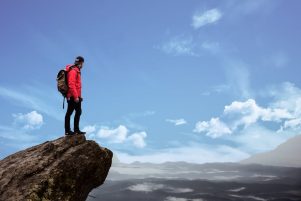Scaling An Inner Summit
Article By Vishal Pahlajani
 “Adopt the pace of nature: her secret is patience.” – Ralph Waldo Emerson
“Adopt the pace of nature: her secret is patience.” – Ralph Waldo Emerson
Throughout the ages nature has time and again instilled a sense of awe and wonder within human beings; at her unparalleled beauty, at her mysterious methodology and her enigmatic laws that govern the universe.
The ancient Greek philosophers, specifically the Pre-Socratic philosophers are said to have lived their lives with a deep sense of this mystery. Their deeply rooted understanding of the laws of the universe contributed to their aligning their lives with the path of nature. Plato, as well as the Stoics who followed later, believed all of nature to be an expression of the One – the Divine. This infinite and eternal Divine Unity, the Divine spirit manifests itself in the plurality of the material realm, animating it so as to embark on a journey of growth and development, an expansion of consciousness, which eventually leads back to the source to complete a cycle. According to the Greeks, as human beings, we have the unique potential to consciously explore this path of merging back into the infinite source: the path of Beauty, Justice, Goodness and Truth. This multitude of expressions, when researched, understood and practiced, yield to a process of discovery that brings us closer to our origin.
“I am seeking the unknown in myself…Through the wilderness I can go deeper and deeper into the layers of my unknown inner being.” – Reinhold Messner
In a world, impermanent by nature, in which we give temporary qualities dominant importance, there is a danger of becoming entrenched in the acquisition of material objects and artificial manmade “duties” which typically serve selfish needs related to the personality’s base desires. Concurrently, there develops a sense of imprisonment that begs to be vanquished; an imprisonment of the inner being which has within it the implicit need to be unleashed, although it might have yet remained unheard, almost unnoticed. This silent call of the inner being strengthens. It is a call to fulfill and realize its own true potential – to do justice to its external manifestation. In the human context, this reveals the true purpose of our personalities as tools that must be used to live our swadharma, to recognize the larger role and purpose of our life.
In my experience, one way to burn away the illusion of the strong external material current – thereby allowing the inner voice to be noticed – is to venture into nature, retreat into the mountains, with the definite purpose of climbing to the peak.
In contrast to the typically fleeting events and occurrences we experience within the city, mountains exhibit a quality of permanence and stability in an immense sustained form. It sometimes feels as if they even emanate a magnetic force of attraction which draws you towards them gradually. Man’s higher self, his profound and eternal identity, resonates and identifies with the manifestation of these divine and harmonious qualities of the mountains. Perhaps, many peaks in the Himalayas serve as sights of pilgrimage precisely because their scaling peaks appeal so strongly to our inner being.
There are mythologies which talk about mountains that are said to hold within them keys to the mysteries of nature, waiting to be unlocked. This beautiful symbolism is seen across various cultures throughout human history. Some cultures have emulated the essential structure of a mountain in their sacred monuments for example, the pyramids in Egypt and in Peru, and the architectural form of Indian temples. The construction of these pyramids and temples perhaps symbolized for pharaohs and priests the relationship between the macrocosm and the microcosm, Unity and plurality, the Divine and man. It is evident that these structures served as a bridge to connect the Divine aspect within man to the Divine source. Similarly, scaling a mountain might reveal our own Divine nature, our true selves.
“I am climbing in the higher altitudes for knowing myself…not just to explore the mountains.” – Reinhold Messner
It all begins with the intention, the Will. Once the intention to climb a peak has been established, work towards that goal begins. Preparing and working with a plan, with discipline, perseverance and consistency. The preparation includes becoming capable physically, but also taking care of logistics and acquiring equipment well in advance. There cannot be any doubts about gear malfunction; God forbid your gloves aren’t warm enough on a cold night while climbing in the snow. Packing equipment and tools for the journey serves as an exercise in discernment, to leave behind the non-essential and only carry what might really be required.
Beyond the materials, there needs to be resilience at the emotional and mental level as well. This preparation is done alone, with our own will and our individual effort. A guide or mentor might encourage you, and provide tips and suggestions, but the work remains your own.
The actual journey finally begins with an approach trek to base camp. The challenges here are fairly negligible, and are certainly worth overcoming in view of the beautiful landscape. Deep valleys, rushing rivers and stunning blue skies excite the personality and arouse sentiments that awaken the soul.
As you ascend higher, the air becomes thinner, containing less oxygen. Consequently, one requires more energy to do any kind of work. Without “acclimatizing” in a proper manner to this higher altitude, even laughing can cause one to feel breathless. Therefore, the lesser the material belongings you carry, the more efficient you would be while climbing.
Then there is the unpredictability of the weather which too could create opportunities for one to demonstrate dauntlessness from within. Being so high up in the mountains brings you closer to the clouds, when a thunderstorm happens, it is not above you, but all around you – the thunderclaps that echo all around you, are an unparalleled dramatic experience. The immense splendor and magnificence of the mountains can sometimes beguile the personality, causing us to forget how menacing and merciless the mountains can be. A violent avalanche could easily wipe out the most carefully pitched tents even if the campsite has been ideally placed. These are just some of the various hazards that one needs to be aware of and so one has to be constantly in a state of attention, watchfulness, and awareness of the environment, and ourselves.
Doubts and fears of all kind need to be set aside, no matter how deeply rooted, and replaced with strength, courage and conviction. A sense of bold and deliberate confidence in your preparation and abilities – which you have been working on – are just as essential as any gear or material objects required to facilitate the climb. As progress is gradually made, it develops into a process of inner purification and cleansing, as you shed away layer upon layer of defects and vices such as arrogance, weakness or cowardice. Limitations of the physical, energetic, emotional and mental planes need to be overcome thereby allowing the Will of the higher self to supersede the voices of the lower, through virtues of temperance, patience, persistence, focus, attention and precision.
And finally the climax – known as “summit day”. The team is ready to make the attempt for the last leg of the climb, the peak. It is initiated at night when the snow is more stable. The typical summit day climb of 10 to 15 hours roundtrip culminates with the arrival to the peak at around sunrise which also allows for the most incredible and awe-inspiring panoramic views.
Climbing on summit night is an activity that compels you to dive inwards, with each step forward, until the final goal has been attained. I experienced it as a soul searching effort that concentrates the attention of the senses, awakening a profound sense of belonging, a widened consciousness.
And yet, all this soul searching may still not yield the eventual goal of reaching the top of the mountain due to the many risky obstacles which could potentially create a fatal situation. Soft and fresh snow for example, could easily trigger an avalanche which is a very real threat to any climb. A less radical event but unpleasant nonetheless, could be a situation of strong winds and low temperatures causing frost bite. These risks are an immense lesson in humility and respect towards the forces being encountered. It makes you appreciate and admire the vitality and exuberance of nature, while respecting her power and ability to slowly, but surely, bring you face to face with some of her laws, both physically as well as internally. It is an exercise in an expansion of consciousness, to slowly encompass all elements at various levels and dispel the darkness of doubt, the fear of the unknown.
However, when this journey is successful and the goal is attained, the sense of elation, joy and glory is a glimpse into another realm. It fills the being with an uplifting sentiment which is empowering yet humbling. Upon returning from this sort of journey one can spend days and even weeks reflecting on the entire experience. The accomplishment intoxicates, and is initially exhilarating, electrifying and inspirational. Allowing the nature of inner being to manifest pushes the boundaries of the personality and helps overcome the limitations set by our fears and comforts. As we go back into our more familiar environment, the comfort zone of the city, we again lose this sense of empowerment. The material forces once again dominate, and all that remains is a faint memory of what it was like to BE – free of the confines of the personality.
This “spiritual hangover” might inspire us to let go of the many layers that blanket our inner being; layers of worries, fears, anxieties, doubts, inhibitions, and the imperfections surrounding us, which are not really attributes of our true eternal and divine identity. We must dare to go beyond the illusion of separation, to be able to allow the inner being to blossom, no matter what the task at hand, and no matter where we are conducting ourselves. Doing so might enable us to encounter the beauty of life, and the Divine which expresses itself throughout the material realm. It will allow our higher being to express itself through our efforts and our work, leading us to a place of sustainable happiness, joy and gratitude.
“It’s not the mountain we conquer but ourselves.” – Edmund Hillary
Image Credits: By Creative Market | Pixabay | CC0
The entity posting this article assumes the responsibility that images used in this article have the requisite permissionsImage References
By Creative Market / pixabaycom / CC0
Permissions required for the publishing of this article have been obtained




What do you think?